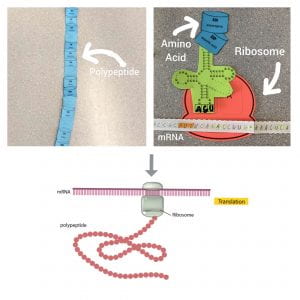AP12 – mRNA and DNA –
DNA vs. mRNA
Messenger ribonucleic acid (mRNA), possesses all the basic characteristics of RNA, and it acts as a complementary strand to one of DNA’s strands. While the composition of DNA and RNA are similar, there are a few differences between mRNA and DNA:

• mRNA is made up of ribose sugars, while DNA is made up of deoxyribose sugars (a ribose sugar that has been de-oxygenated).
• They contain different pyrimidines. DNA utilizes thymine, while mRNA has uracil.
• While DNA is present in the nucleus (of eukaryotes), mRNA will diffuse into the cytoplasm after it’s synthesis.
• DNA is double-stranded, while mRNA is single-stranded.
• mRNA has a short lifespan, while DNA has a long lifespan.
Using pipe cleaners to represent the differences:

Building pipe cleaners to represent this, is very useful. You are able to very easily tell the differences in the structure, as you will have to build both the DNA, and mRNA strands. However, there is some difficulty in observing some differences, such as one being built of deoxyribonucleic acid, while the other is oxygenized, or representing that DNA is present in the nucleus while mRNA is present in cytoplasm after synthesis. Ultimately, I can strongly recommend using pipe cleaners to build both, as it is very helpful for your understanding of both, and helps familiarize you with their shapes in a non-intimidating manner.
Transcription and Translation:
The process of transcription is very similar to DNA replication; however, it will only take place on one backbone, unwinding, complimentary base pairing, joining, all facilitated by the enzyme RNA polymerase. The process of transcription will take the information that is encoded in the gene of DNA, and encode that same information in mRNA.

A crucial piece of transcription, is RNA polymerase (which are large enzymes with multiple subunits), as it will carry out the process of transcribing DNA into RNA. Thus, creating a new RNA molecule through base pairing. First, the RNA polymerase will bind to the start sequence of DNA. Once it has found this codon, the RNA polymerase will separate the strands of a section of DNA (which is called a transcription bubble), which will provide the single stranded template that is needed for transcription (which is referred to as the template strand).


Secondly, the RNA polymerase will read the DNA strand one base at a time, and will concurrently build an RNA molecule through complementary nucleotides, creating a chain (that will go in the 5’ to 3’ direction). Essentially, during this step the elongation of the RNA strand becomes longer, due to an addition of nucleotides. Finally, the mRNA strands will have been copied and paired from the DNA template strand. This involves a stop codon, that will signal that the RNA transcript is complete. It will then cause the transcript to be released from the RNA polymerase.
During translation, the codons of the mRNA strand are read (in the 5′ to 3′ direction) by tRNAs. Every tRNA contains a set of anticodons (a set of three nucleotides that will bond to the matching bases on the mRNA strand through base pairing), and attached to the top of the tRNA is the complimentary amino acid to the anticodon that it carries. tRNA will then bond to the mRNA strands through the ribosome which is reading the complimentary base codon for it to bond to. Once two tRNAs are present and bonded, their amino acids will also bond together through peptide bonds. This will eventually result in a chain of amino acids (polypeptide), which creates a protein. Translation is composed of three steps: initiaition, elongation and termination.

During initiation, the ribosome reads the mRNA codons, beginning the process once it reads the start codon (AUG).
Next, elongation occurs, where the ribosome will begin to move along the mRNA and continue to read its codons. While reading the individual

codons, a complementary tRNA containing on one of its ends, the anticodon for the mRNA codon, and on the other end, the matching amino acid for the anticodon. Once a second tRNA has bonded to the mRNA strand, the amino acids will also bond together through peptide bonds,

eventually creating an amino acid chain (polypeptide), resulting in a protein. Once both tRNAs have arrived, and both amino acids have bonded together, the first tRNA, will leave, and the second will move to take its place, as the ribosome moves onto the next codon of the mRNA strand.

The third step, termination, is the process where the ribosome reads a stop codon on the mRNA strand, and as there is no complimentary tRNA for a stop codonm, it will inform the ribosome to release the mRNA, thus ending the amino acid chain.


How using pipe cleaners to represent these processes could be useful:
this activity did a good job of representing translation, because we were able to visually understand not only the processes of tRNA and amino acids, but also the reading and pairing of codons. I found it very useful to be able to act out the processes myself, because I was then able to better remember it and deepen my knowledge. I also enjoyed being able to pair the original DNA strand to it’s nucleic base pairings in order to create the copied mRNA strand. However, I think that it could have been more helpful to in corporate the pipe cleaner DNA into this process, as it would allow for a better visual representation of the DNA being copied. I also think that the ribosome created by rRNA and it’s reading of the codons could have been better represented by cutting out the three individual places (mouth, A, and P) to better visualize it’s process. Ultimately, I found this experience very helpful in demonstrating translation and helping me remember its process.


